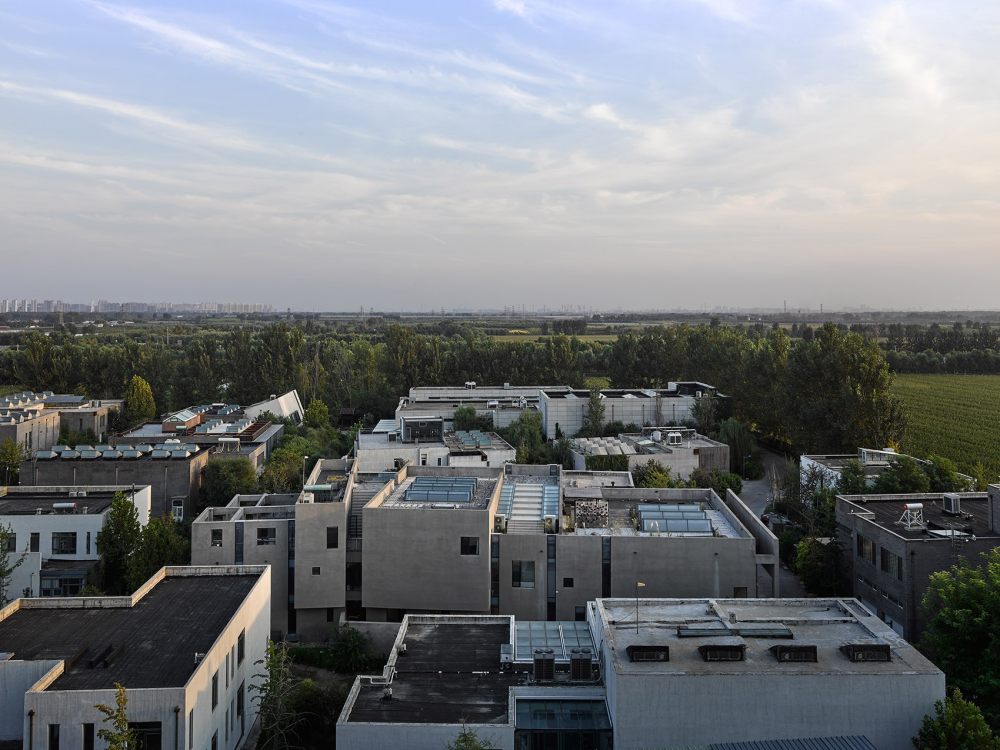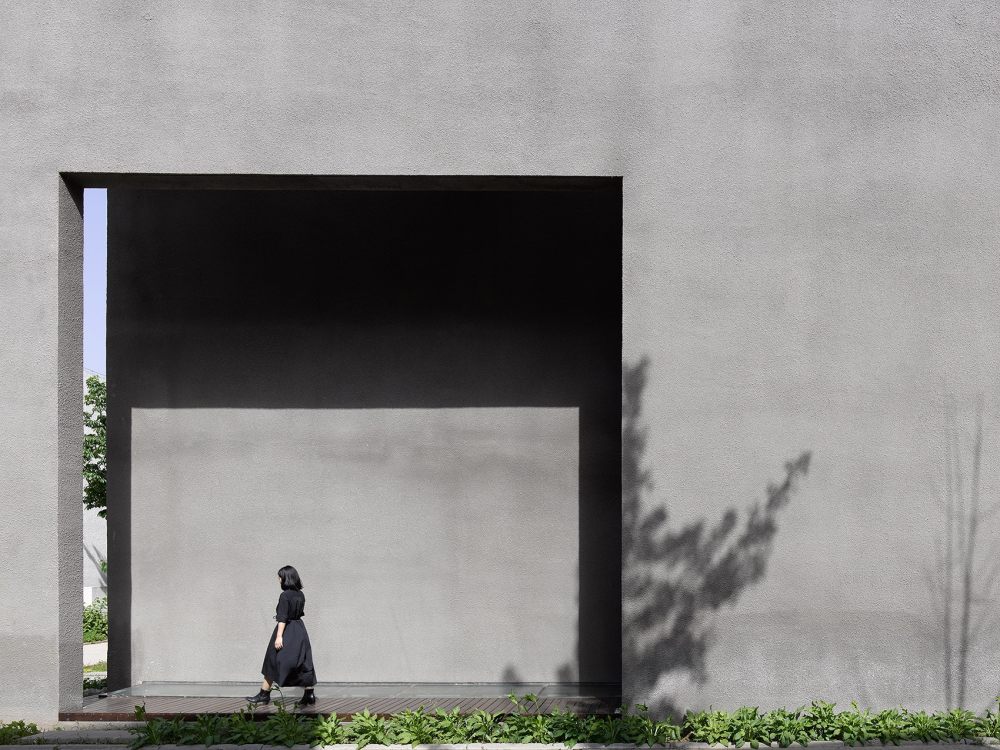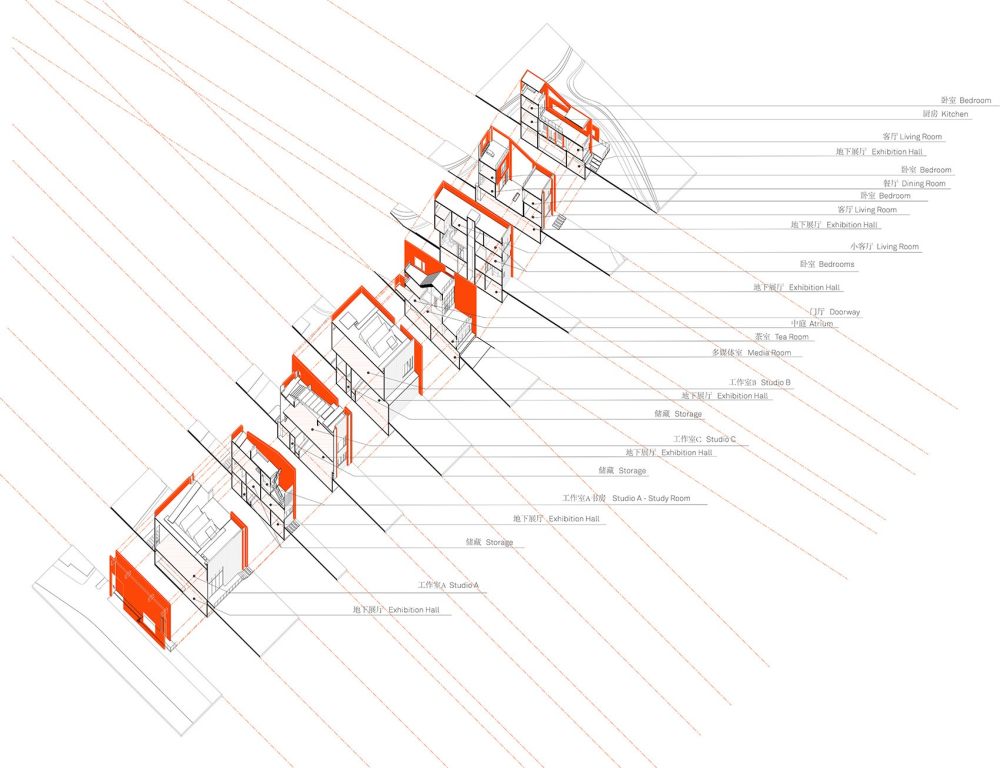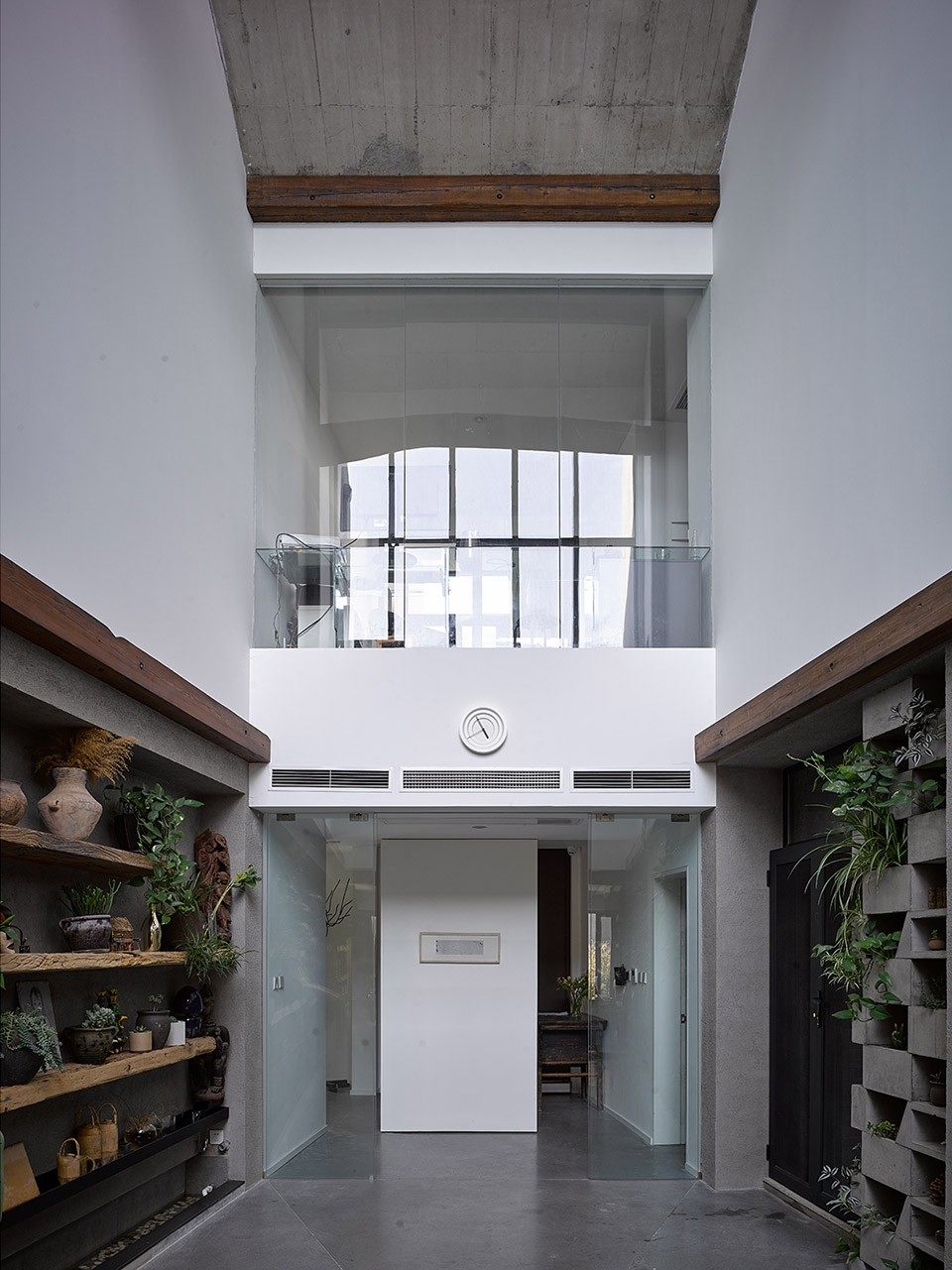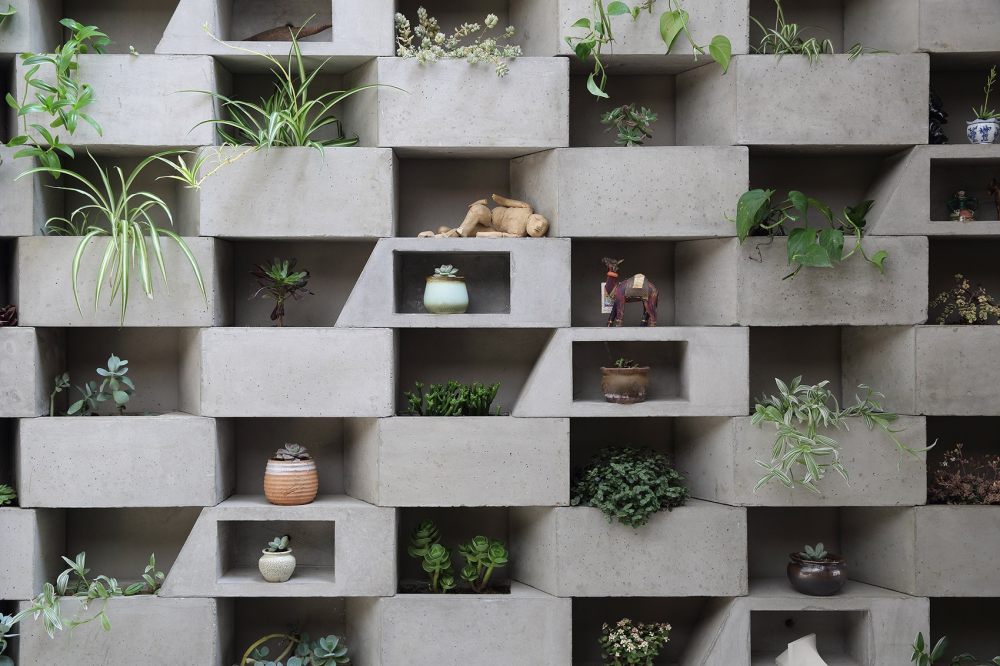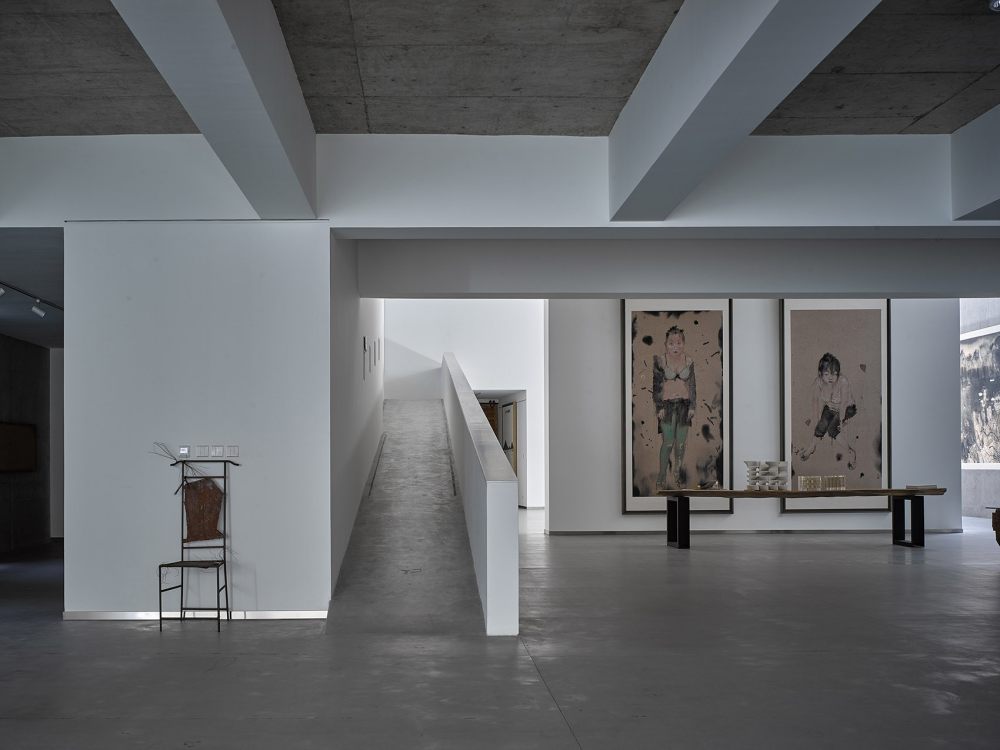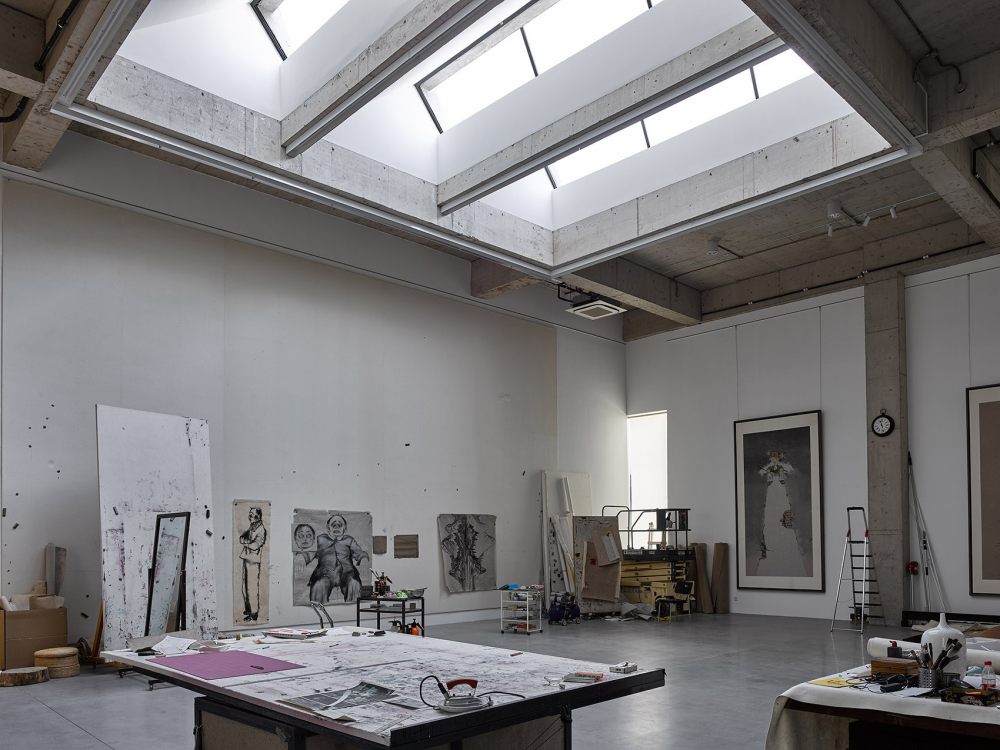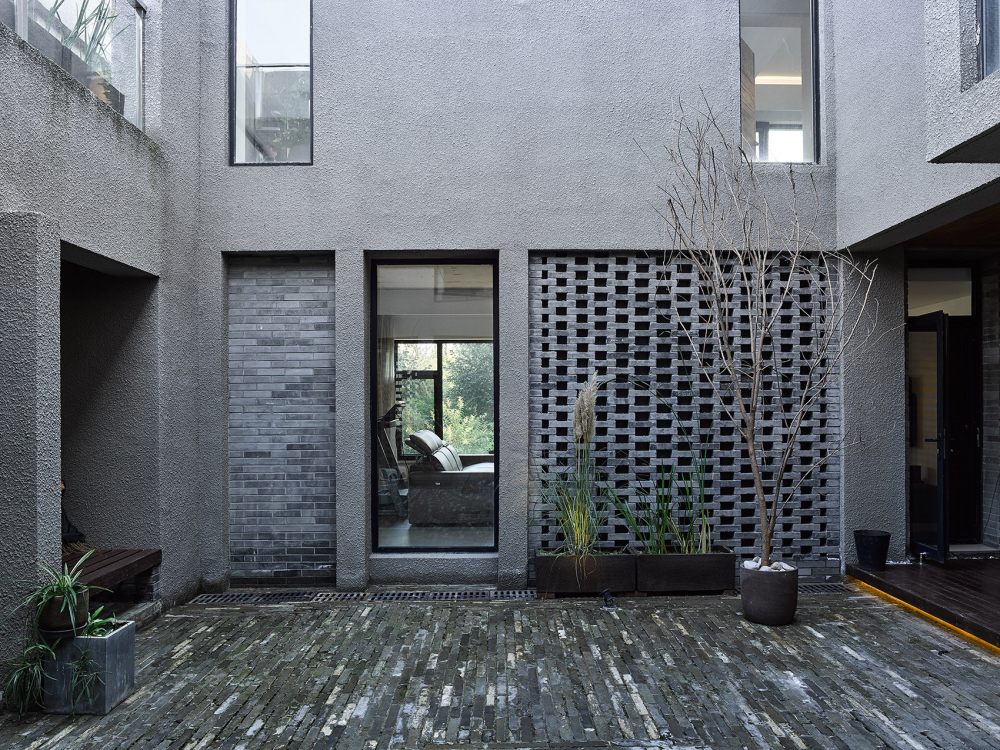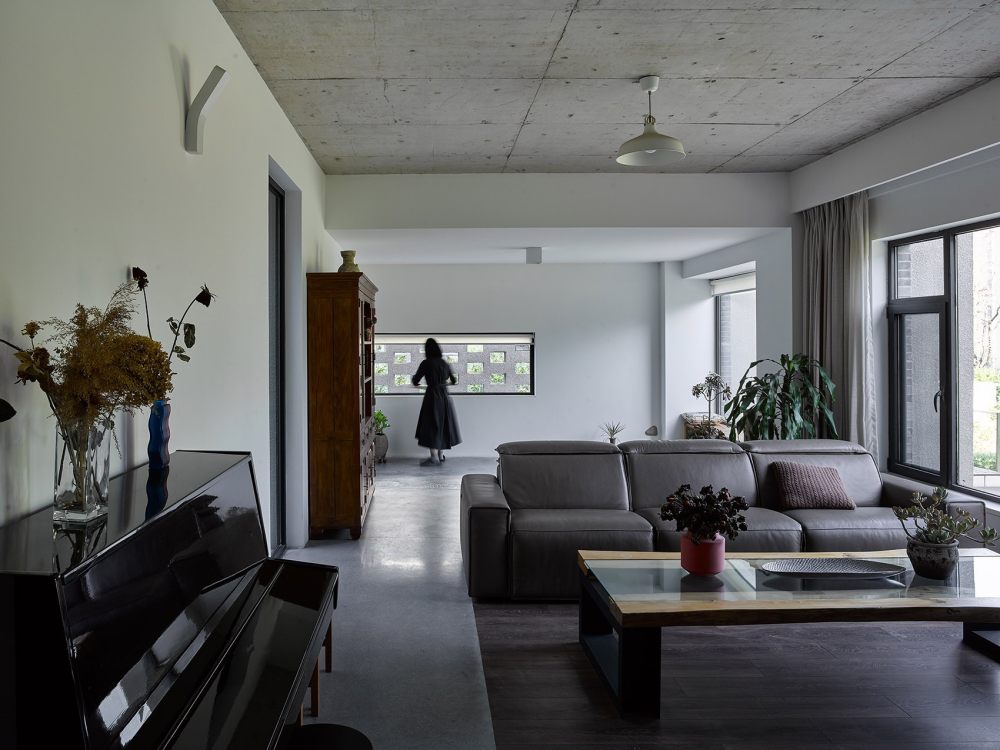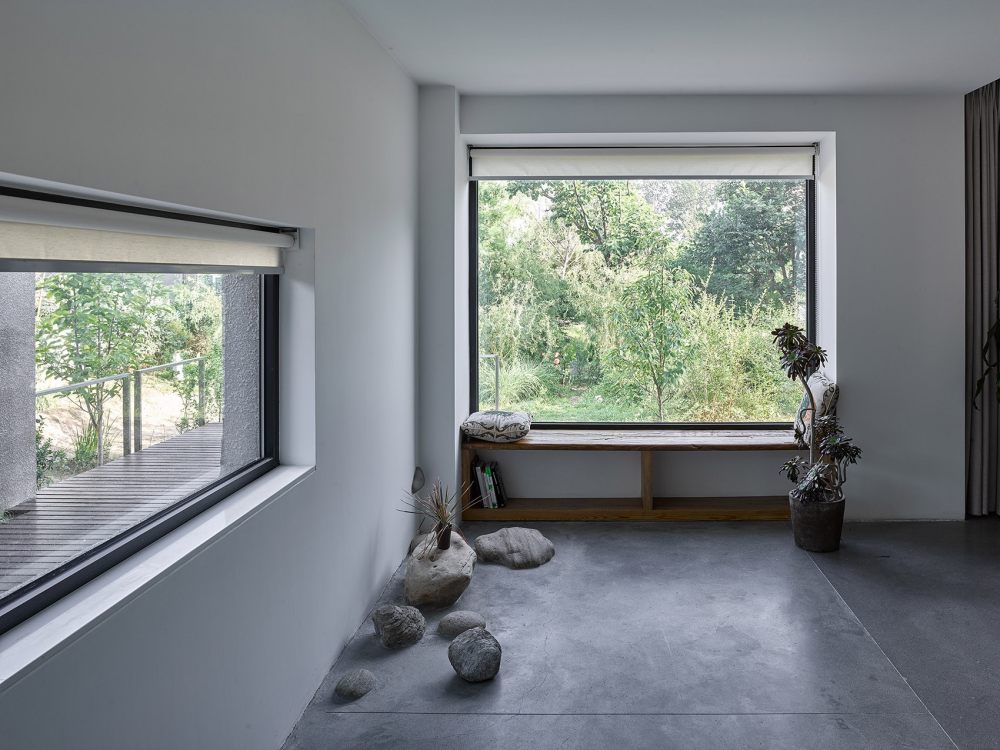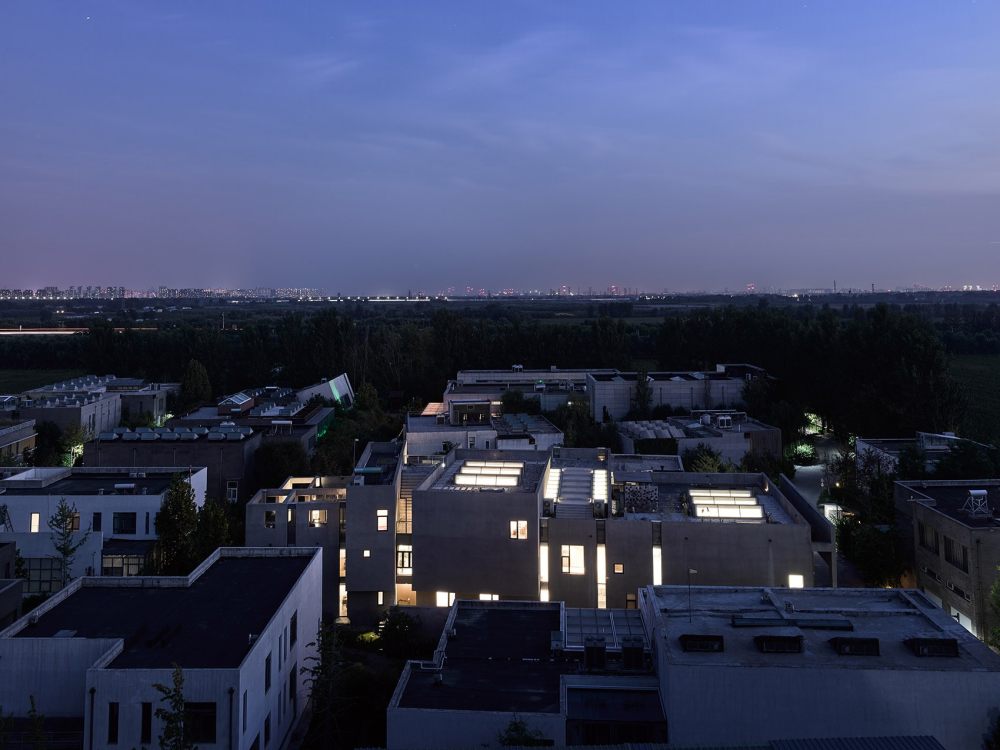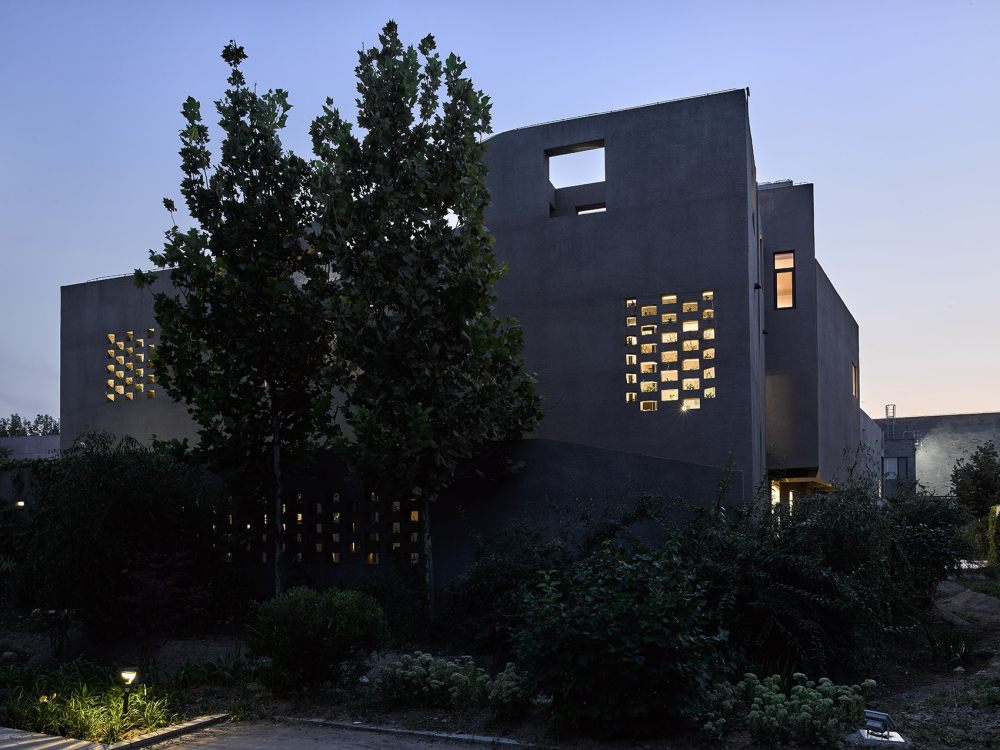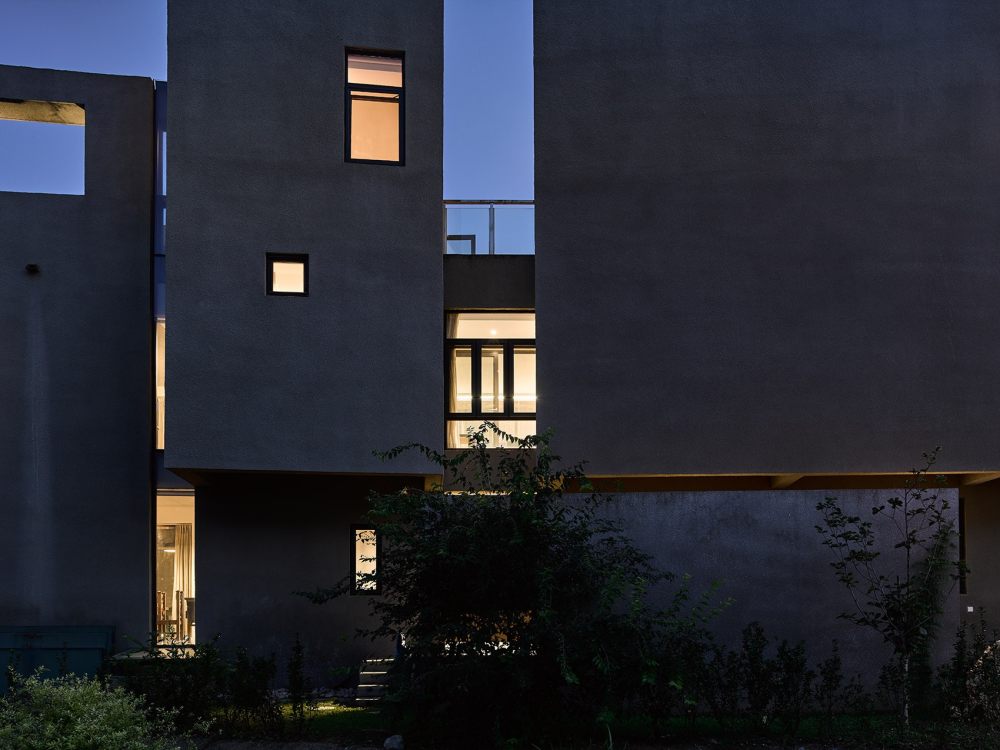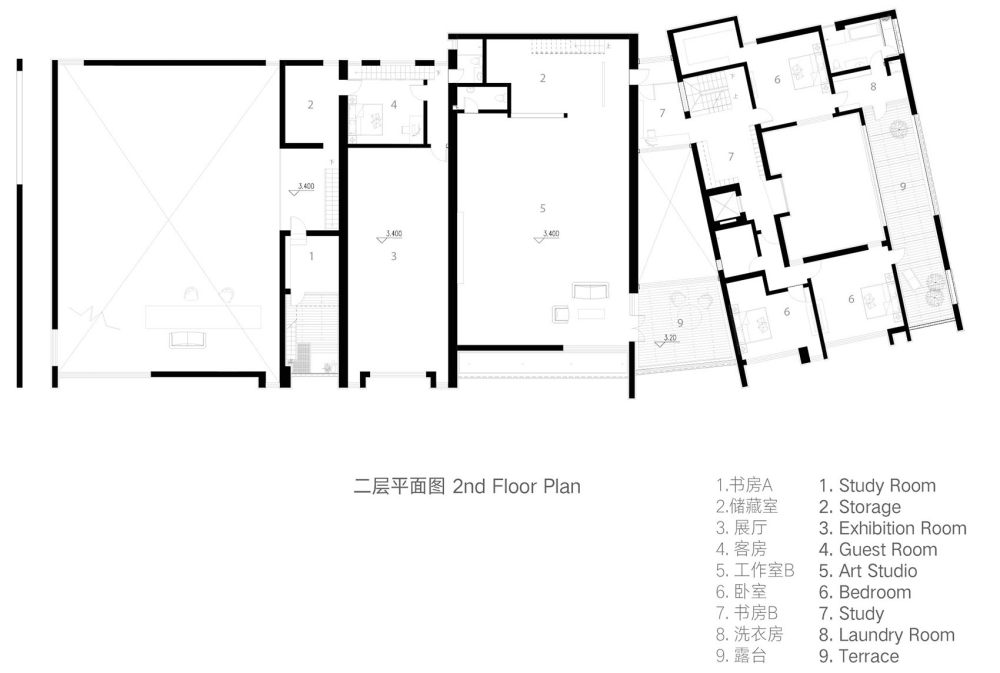本帖最后由 焉尘建筑设计 于 2019-12-16 09:39 编辑
“垣宅”位于顺义的一个艺术社区内,是为一对夫妻艺术家设计的工作室及居所, 从选址、设计到建造完成历时四年。业主希望这座新的建筑可以满足他们各自不同艺术创作以及家庭生活起居的需求,同时也可以作为二人的私人美术馆,定期对外开放展示。
Located in an art community in Shunyi District of Beijing, the House of Walls is designed for an artist couple as their studio and home. The process of site selection, design and construction took four years. The couple requested that the new building should fit their different needs in art creation and daily life while at the same time functions as a private art museum that regularly opens.
▼项目鸟瞰,aerial view of the project ©孙海霆
“垣宅”不是一个普通的住宅,她既需要承载日常生活的琐碎,又需要容纳超越日常的情愫。而建筑师面临的也并非一对夫妻艺术家之间的二元关系,而是一个三维立体关系:对于一个家庭而言,既有二人之间的夫妻情感,又有两位艺术同行之间的比较与观察;对于每位个体而言,既有艺术家与自己作品之间的对话,也有生活与工作的角色转换;同时,对于建筑空间而言,其所要包容的既是一个私人场所,又在特定的时间点具备公共性与社交性。
The House of Walls is not a regular house. She needs to encompass the trivial mundane life as well as transcends beyond the daily routine. The task that the architect facing here is not the duality between the two artists, but a three dimensional relationship: as a family, they are a couple and peers; as individuals, they face their own works as well as the other selves. The building is designed within the private domain but with characteristics of publicity and sociality at certain moment.
▼北立面,north elevation ©孙海霆
这些暧昧、矛盾、复杂的关系所带来的是一系列冲突,不同生活戏剧场景的同时上演,亟需一个拥有秩序的空间架构来包容及串联。在纵长的地块上,由西向东展开了一系列不同厚度、高矮的“墙”。墙的作用是隔离或限定。墙或限定着一个厚重的体量,或挤压着一个狭小的空间,抑或相夹着裸露的虚无。“墙”是作为实体的基本要素,同时也是隐喻性的思想实验素材。“墙”在立面上建立了清晰的逻辑,划立了一条条等待被突破的边界,墙建立的网格成为了生活的坐标,赋予了生活与创作的无限可能。
The conflicts triggered by the ambiguous, contradictory and complex relationships, as well as the simultaneous play of different life scenes urgently need the containment of an orderly space framework. A series of walls with different heights and thicknesses stand on a long strip of land. On the facade, “the walls” are either defining a large volume, squeezing a narrow space, or holding nothing but emptiness. The walls are the basic elements of physical objects and also the experimental materials of architectural thoughts. “The walls” build up a clear logic, and mark the boundaries awaiting to be broken through. The coordinate grid that the walls established enables the infinite possibilities of life and creation.
▼西立面,west elevation ©孙海霆
墙呈U字型从北向南包裹着不同厚度的体量,并向南侧继续延伸,每一组墙之间以800mm宽的竖向玻璃幕墙相分离,打破艺术空间的大体量。在作为主入口的北立面庄重而含蓄,建筑呈现有节奏的体块;而在更加私密的南立面则自由而开放,每一组墙所限定的空间对应着不同的功能属性,不同的光线需求呈现出丰富多样的立面表达。
The U-shaped walls wrap around the space-room in various sizes from the north and extend to the south. Each set of walls are separated by an 800mm-gap filled with tall stripe of glass curtain wall in order to bring the scale down. The north façade is implicit and solemn, presenting as rhythmed massing blocks with only limited openings. The south façade is more private, intending to exhibit freedom and openness between the walls. The walls framing different programs and lighting condition give a metabolic south facade expression.
▼分解轴测图,exploded axonometric
在入口处,连续而立的墙面发生了一个微妙的转折,左右两个墙面向南侧扇形展开,相夹着一个双层通高,由门厅到中庭、茶室、竹林逐渐开朗的梯形空间。中庭是整座建筑的核心,是生活空间与工作空间的过渡。这个转角使生活区拥有更好的朝向和视野,同时改变了室内步行的方向和路径,暗示个人状态与角色的转变。在中庭与门厅之间、中庭与茶室之间各有一道旋转隔断,让中庭在不同的时间段可以满足会客、宴请、步行与运输等不同需求。中庭的设计无论从光线、材料和氛围上都意图表现一处庭院化的冬季花园:朽木与水泥的对比、局部下沉的地面与中心鹅卵石铺装、流水潺潺的金属水槽,以及由特制的混凝土空心砖砌筑的种植墙面。植物与不断添加的艺术小品、朽木与混凝土共同生长氧化,坚硬与柔软发生着对比,静止与摇曳相互呼应。各种元素不断调节着室内微环境,让空间成为一个有机的整体。
▼剖面图,中庭是建筑的核心,section, atrium is the core of the entire building

At the entrance, the wall sequence turns a small angle, with the neighboring walls framing a special interstitial space, extending from the entrance to the double-height atrium, the tearoom and the bamboo groove. The atrium is the core of the entire building, acting as the transition between the studio and living quarter. The subtle shift of angle allows ideal orientation and view for the living quarter, and at the same time marks a transitional moment along the interior walking path, indicating a switch of personal state between work and life. The atrium is vaguely separated by two rotating screen walls from the entrance and the tearoom, allowing different usage of the atrium from winter garden to dinner party. The light, materiality and atmosphere of the atrium is intentionally designed as that of an exterior patio, with the sunken terrazzo floor, recycled wood shelves, a metal water sink and a wall built with prefabricated concrete planters in it. The vegetation and the art artefacts, the wood and the concrete are aging as a union, celebrating a contrast between the hard and the soft, the still and the mobile, continuously tuning the micro-environment of the atrium.
▼入口中庭,atrium at the entrance ©孙海霆
▼预制混凝土花盆砖,precast concrete brick ©孙海霆
中庭以西是访客参观的起点,展厅位于地下空间,坡道从局部的挑空空间进入展厅,增加了进入的仪式感,削弱了楼层的变化。为了最大程度的相互独立,两位艺术家的工作室虽然直线距离并不很远,但却位于建筑流线上的最远点。过道、坡道、步道使得探访的距离与时间被刻意增加了。位于一层的国画工作室被两组U字型的墙体包裹,西侧的大空间是主要的创作空间,而紧邻的长条形的空间与主创作空间以连续的滑轨墙相隔:这里容纳着卫生间、储藏室、一层书画案台与二层书房、二层小露台等服务型空间。油画工作室则位于展厅的上方,两位艺术家需要通过居住区域才可以彼此探访。
▼通向地下展厅的坡道,ramp to the underground exhibition room ©孙海霆
▼地下展厅,underground exhibition space ©孙海霆
▼展厅西侧天窗,skylight on the west side of the exhibition space ©孙海霆
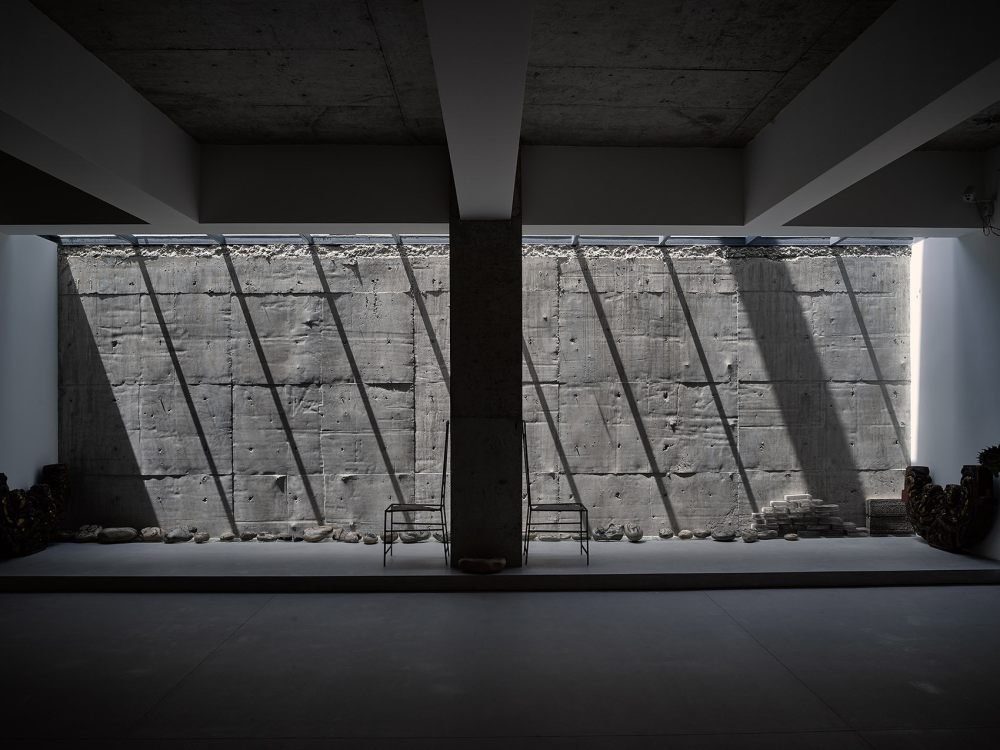
A visit usually starts from the west side of the atrium. The exhibition space is located on the underground floor, reached by a ramp from the double height space. The change of floor level is less perceivable. In order to maximize the independent status of the two art studios, they are located on two farthest points on the circulation though the direct distance is quite close. The passages, ramps and corridors elongate the distance and time of visiting. The ground floor Chinese Painting art studio is composed of two identifiable spaces wrapped around by two U-shape walls. The space on the west is the main working studio, while the other is the long narrow space separated by the sliding walls. It contains all the service space, including a small painting room, storage and restroom on the ground floor, and study room together with a private terrace on the mezzanine floor. The oil painting studio is located above the exhibition space. The couple could visit each other only by walking through the living quarter.
▼走廊,corridor ©孙海霆
▼国画室和二层书房,studio for Chinese painting with a study room on the second floor ©孙海霆
在中庭以东,便是回归小尺度的家庭生活空间了。从东侧的矮墙开始,三组尺度更加密集的墙体定义了由东到西一系列微妙的室内外空间转换:从东侧的室外平台、到东侧入口的廊道、私密的内庭院、到与庭院相接的有遮盖平台、再到之前的室外化的中庭空间,一明一暗交替出现。而几组对称的建筑语汇:餐厅与客厅围绕内庭院的相望、庭院内作为地下书库天窗的水池、垂直的电梯玻璃盒、电梯上方的跃层飘窗共同暗示出了一条东西向的副轴线,以及东入口作为建筑仪门的存在。
On the east of the atrium, the scale goes to domestic life. Starting from the low wall on the east, three sets of U-shape walls define a series of transition between interior and exterior: from the east terrace, the east interior gallery, the private inner courtyard, to the semi-exterior covered platform and the exteriorized atrium. The dark and the light alternates. Several sets of symmetrical language, including the visual pair of the dining room and the living room, the water sink skylight, the vertical elevator box and the double-height bay window, all indicate the status of the east gate as the ceremonial entrance of the house.
▼内庭院,inner courtyard ©孙海霆
▼客厅,living room ©孙海霆
墙同样塑造并限定着屋顶的空间。屋顶平台与地下展厅一起,是建筑中两处连续的“破墙”空间。被墙“隔离”的空间可以通过屋顶的露台更便捷地彼此探访。屋顶平台的入口位于中庭的上方,沿着位于油画工作室体块与居住区体块之间的空间向上,豁然开朗。倾斜的屋面向上或向下,形成连续完整的屋顶漫步体验,形成有雕塑感的屋顶造型,打破了墙的界限,成为了家庭内的公共空间。
The walls also sculpt and define the rooftop space, which “breaks” the walls together with the underground exhibition space. The rooms isolated by the walls could be easily visited by the roof terrace. The entrance to the roof terrace locates on top of the atrium, squeezed by the blocks of oil painting studio and living quarter. The stepped roof terraces lead up and down, creating the sculptural form and the continuous promenade experience, breaking the boundary of the walls. The roof becomes the public space within the family.
▼夜景,night view ©孙海霆
▼一层平面图,first floor plan
▼(左)二层平面图,(left) second floor plan
(右)三层平面图,(right) third floor plan
项目名称:垣宅艺术家工作室
设计方:焉尘建筑设计工作室
联系邮箱:Contact@dustartoffice.com
项目设计&完成年份:2014 – 2018
主创及设计团队:刘焉陈
项目地址:北京市顺义区李桥镇
建筑面积:2100平方米
摄影师:孙海霆、刘焉陈
客户:私人业主
品牌:蓝宝清水混凝土
|

